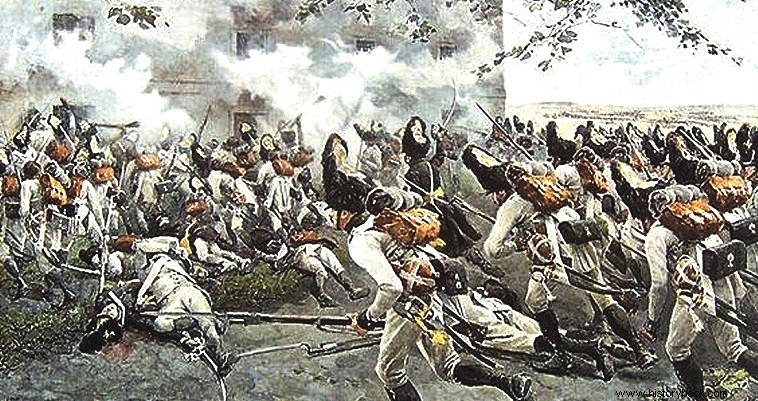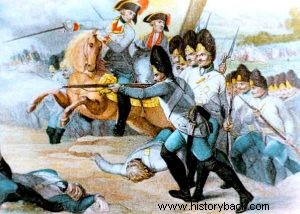
The grenadiers, as a distinct type of infantry, appeared in the 17th century although incendiary, "biological" or explosive grenades existed centuries before. In the Austrian Army, the grenadiers wrote their own history especially during the difficult period of the French Revolution and the Napoleonic Wars.
From about 1700 until 1805 the Austrian infantry regiments had almost this organization. Each regiment fielded two battalions of infantry with six companies of musketeers and one infantry battalion with four companies. Also each regiment extended two companies of elite grenadiers.
The grenadiers, as their name suggests, were the soldiers who used grenades (granate in German) . Each grenadier carried 3-5 grenades in a special case, along with a fuse and flintlocks to light it. But as early as 1720, the grenadiers abandoned grenades, which they continued to use only in siege operations.
In addition to hand grenades, the grenadiers carried the typical infantry armament of the time, i.e. a smoothbore musket, a sword and a bayonet. Also, their uniforms were indistinguishable from those of other pedestrians with the exception of the tall fur hat they wore.
In 1792 when "democratic" France declared war on Austria, the Austrian infantry regiment had the above mentioned organization. The grenadier companies numbered about 140 men – a captain, a lieutenant, a second lieutenant, a corporal, four non-commissioned officers, a corporal and 131 grenadiers. This organizational model was maintained until 1805, when the reforms of the infamous General Mack came into effect.
Under the new organizational chart each infantry regiment extended four musketeer battalions of four companies and a grenadier battalion also of four companies, each company having 160 men. After the disastrous defeats at Ulm and Austerlitz, however, both General Mack and his reforms ended up in the junk basket, and under the leadership of Archduke Charles of Habsburg, the previous organizational model was restored, with the exception that the field battalion now became active .
According to tradition, already from the time of the wars of the great soldier Prince Eugene of Savoy, the grenadier companies of the infantry regiments were detached from the familiar formations and formed independent grenadier battalions. Each battalion consisted of four companies.
This elite force usually constituted the reserve of the command and was thrown into battle either to support the friendly faction if it showed signs of inflection, or to crush the enemy with a strong fanatical raid.
The men who were assigned to the grenadier companies were as a rule the fittest and most robust. They were trained very hard and became able to shoot quickly and coolly, but also to fight from the cluster with the sword and the bayonet. The usual battle formation was that of a line of three yoke. However, from 1805 onwards the formation of the attack phalanx was also adopted.
When facing opposing cavalry they would either form an open square, or "mass" – a very dense phalanx formation – or, if the opposing cavalry could not outflank them, remain in line formation repelling the attack with fire and drawn bayonets.
The men wore the standard white infantry uniform with the colors of their respective regiments on the sleeves, collar and sleeve ends. Like the rest of the infantry, the grenadiers wore short breeches and high black gaiters that reached almost to knee height.
Having abandoned the grenades, they only carried a black wooden cartridge case with a metal shield with the flaming stream, which was their emblem which was suspended from the left shoulder with a white leather strap. The grenadiers, like the musketeers, of the Hungarian regiments wore tight blue trousers.
From the right shoulder was also suspended with a white strap the sword and the bayonet. Also hanging from the right shoulder was the strap, brown in color, that made up the water container. The grenadiers carried the same knapsack as the musketeers, on which hung the gray cloth. The sword had a blade length of about 50 cm and was slightly curved. The non-commissioned officers' swords were larger.
Junior officers wore the same uniforms as their men. The sleeve was fastened at the front with a series of metal buttons. Officers wore a gold-embroidered belt, boots and long curved swords. On the hats there was a metal shield with the double-headed eagle of the Habsburgs. Non-commissioned officers and grenadiers carried, until 1798-1800, the Model 1748 musket and then the Model 1798 musket of 17.5mm caliber. and weighing about 4.55 kg.
The Austrian grenadiers distinguished themselves in all the battles they participated in, victorious or not, such as Zemappe in 1792, Marengo in 1800, Aspren Essling, Wagram and Tschneim in 1809, Dresden and Leipzig in 1813.

